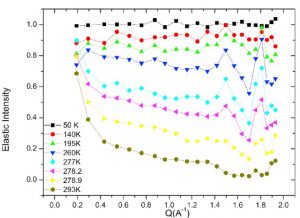Daniela Russo, Maya Dimova Lambreva, Christiane Alba Simionesco, Pierre Sebban,and Giuseppina Rea
Studies on the dynamical properties of photosynthetic membranes of land plants and purple bacteria have been previously performed by neutron spectroscopy, revealing a tight coupling between specific photochemical reactions and macromolecular dynamics. Here, we probed the intrinsic dynamics of biotechnologically useful mutants of the green alga Chlamydomonas reinhardtii by incoherent neutron scattering coupled with prompt chlorophyll fluorescence experiments. We brought to light that single amino acid replacements in the plastoquinone (PQ)-binding niche of the photosystem II D1 protein impair electron transport (ET) efficiency between quinones and confer increased flexibility to the host membranes, expanding to the entire cells. Hence, a more flexible environment in the PQ-binding niche has been associated to a less efficient ET.Asimilar function/dynamics relationship was also demonstrated in Rhodobacter sphaeroides reaction centers having inhibited ET, indicating that flexibility at the quinones region plays a crucial role in evolutionarily distant organisms. Instead, a different functional/dynamical correlation was observed in algal mutants hosting a single amino acid replacement residing in a D1 domain far from the PQ-binding niche. Noteworthy, this mutant displayed the highest degree of flexibility, and besides having a nativelike ET efficiency in physiological conditions, it acquired novel, to our knowledge, phenotypic traits enabling it to preserve a high maximal quantum yield of photosystem II photochemistry in extreme habitats. Overall, in the nanosecond timescale, the degree of the observed flexibility is related to the mutation site; in the picosecond timescale, we highlighted the presence of a more pronounced dynamic heterogeneity in all mutants compared to the native cells, which could be related to a marked chemically heterogeneous environment.
DOI : https://doi.org/10.1016/j.bpj.2019.03.029





